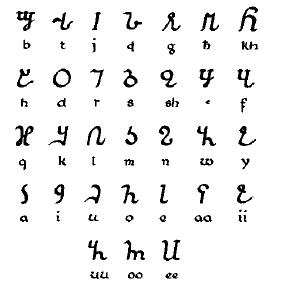Osmanya alphabet: Difference between revisions
m updating link, possibly some formatting, using AWB |
m Standard headings/general fixes |
||
| Line 7: | Line 7: | ||
[[Image:Ciismaniya.jpg|300px|thumb|left|The Osmanya script]] |
[[Image:Ciismaniya.jpg|300px|thumb|left|The Osmanya script]] |
||
[[Image:Cusman.gif|thumb|Osman Yuusuf Keenadiid]] |
[[Image:Cusman.gif|thumb|Osman Yuusuf Keenadiid]] |
||
The '''Osmanya script''' (Somali: ''cismaanya''; Osmanya: |
The '''Osmanya script''' (Somali: ''cismaanya''; Osmanya: ҋҘ҈ґқҒҕҀ), also known as ''far soomaali'' or Somali writing, is a [[writing system|writing script]] created to write the [[Somali language]]. It was invented between [[1920]] and [[1922]] by the [[Sultanate of Hobyo|Sultan of Hobyo]]'s brother, [[Osman Yuusuf Keenadiid]] of the [[Majeerteen]] clan. |
||
The direction of reading and writing is from left to right. The letter names are based on the names of letters in [[Arabic alphabet|Arabic]], and the long vowels uu and ii are represented by the letters waw and ya respectively. |
The direction of reading and writing is from left to right. The letter names are based on the names of letters in [[Arabic alphabet|Arabic]], and the long vowels uu and ii are represented by the letters waw and ya respectively. |
||
| Line 19: | Line 19: | ||
The Osmanya script is available in the Unicode range 10480-104AF [from U+10480 - U+104AF (66688–66735)]. |
The Osmanya script is available in the Unicode range 10480-104AF [from U+10480 - U+104AF (66688–66735)]. |
||
==See |
==See also== |
||
*[[Borama script]] |
*[[Borama script]] |
||
*[[Wadaad's writing]] |
*[[Wadaad's writing]] |
||
Revision as of 01:57, 2 September 2008
| Osmanya | |
|---|---|
| Script type | Alphabet
|
| Direction | Left-to-right |
| Languages | Somali language |
| ISO 15924 | |
| ISO 15924 | Osma (260), Osmanya |
| Unicode | |
Unicode alias | Osmanya |

The Osmanya script (Somali: cismaanya; Osmanya: ҋҘ҈ґқҒҕҀ), also known as far soomaali or Somali writing, is a writing script created to write the Somali language. It was invented between 1920 and 1922 by the Sultan of Hobyo's brother, Osman Yuusuf Keenadiid of the Majeerteen clan.
The direction of reading and writing is from left to right. The letter names are based on the names of letters in Arabic, and the long vowels uu and ii are represented by the letters waw and ya respectively.
While Osmanya gained reasonably wide acceptance in Somalia and quickly produced a considerable body of literature, it proved difficult to spread among the population mainly due to stiff competition from the long-established Arabic script as well as the emerging Latin script.
As nationalist sentiments grew, the adoption of a universally recognized writing script for the Somali language became an important point of discussion. After independence, little progress was made on the issue, as opinion was divided over whether the Arabic or Latin scripts should be used instead.
In 1961, the Osmanya script was made official in Somalia. However, on 21 October 1971, the government of Somali president Siad Barre unilaterally decided to only use the Latin script for writing Somali, and launched a massive education program designed to ensure its sole adoption. This led to a sharp decline in use of Osmanya.
The Osmanya script is available in the Unicode range 10480-104AF [from U+10480 - U+104AF (66688–66735)].
